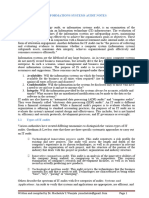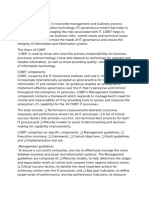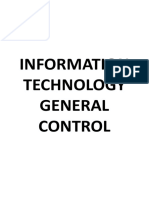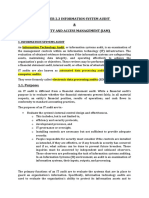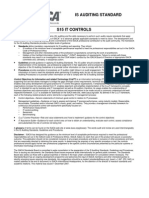Nissctxt
Nissctxt
Uploaded by
MahmoodCopyright:
Available Formats
Nissctxt
Nissctxt
Uploaded by
MahmoodOriginal Title
Copyright
Available Formats
Share this document
Did you find this document useful?
Is this content inappropriate?
Copyright:
Available Formats
Nissctxt
Nissctxt
Uploaded by
MahmoodCopyright:
Available Formats
INFORMATION SYSTEMS AUDITING REQUIREMENTS
John W. Lainhart IV Inspector General U.S. House of Representatives 485 Ford House Office Building Washington, D.C. 20515-9990
Not a new direction or challenge for information systems security, but a direction often not pursued and a challenge often not addressed, information systems auditing is critically required in todays information systems intensive environment. It is required to ensure that our mission critical or lifeblood systems are designed and continue to be maintained with confidentiality, integrity, and availability foremost in mind. In addition, information systems auditing is required by professional auditing standards when information systems are involved in the area being audited. To assist in this effort, a new set of standards, CobiT (Control Objectives for Information and Related Technology) was recently issued which contains both information technology (IT) control objectives, for management and users, and information systems audit guidelines, for auditors. Standards Relating to Audits Involving Information Systems The American Institute of Certified Public Accountants (AICPA) in several Statements on Auditing Standards (SASs), Institute of Internal Auditors Association (IIA) in its Standards for the Professional Practice of Internal Auditing, Information Systems Audit and Control Association (ISACA) in its General Standards for Information Systems Auditors and Statements on Information Systems Auditing Standards, and U.S. General Accounting Office (GAO) in its Government Auditing Standards and Title 2, Accounting, have all taken essentially the same position concerning audits involving information systems. The bottom line is that when an information system is an important and integral part of the operations being audited, the audit should include an appropriate examination of the system to provide reasonable assurance that the information produced by the system is valid and reliable (relevant, accurate, and complete, in light of its intended use). Specifically, GAOs Government Auditing Standards states that auditors should obtain sufficient, competent, and relevant evidence that computer processed data are valid and reliable when those data are significant to the auditors findings. The Government Auditing Standards goes on to state that when the reliability of a computer-based system is the primary objective of the audit, the auditors should conduct a review of the systems general and application controls. Furthermore, in its Appendix III, Accounting System Standards, Chapter 4, Accounting System Development and Modification, of Title 2, GAO states that Offices of Inspectors General (OIGs) are an important factor contributing to successful accounting and financial management system development and modification efforts. GAO indicates that while normally not a member of the project team, auditor involvement is needed in reviewing and evaluating these development and modification efforts.
CobiT -- Control Objectives for Information and Related Technology In order to facilitate this review of information systems, ISACA recently issued CobiT. It was developed as a generally applicable and accepted international standard for good practices for IT controls. CobiT is based on ISACAs existing Control Objectives, enhanced with existing and emerging international technical, professional, regulatory, and industry-specific standards. It was written for three specific audiences -- management, users, and auditors. By using this document, management will be able to review the organizations information systems to make IT investment decisions, balance risks and controls, and benchmark its existing and future IT environments. Users will be able to obtain assurance on the security and control of products they acquire (internally or externally). Finally, auditors will be able to substantiate internal control opinions and identify needed minimum controls for management. CobiT identifies 4 domains with 32 IT processes which form the Framework for from 5 to 25 detailed Control Objectives. The first domain, planning and organization, covers strategy and tactics and concerns the identification of the way IT can best contribute to the achievement of business objectives. It also emphasizes that a proper organization, as well as technological infrastructure, must be in place. The second domain, acquisition and implementation, recognizes that to realize the IT strategy, IT solutions need to be identified, developed, or acquired as well as implemented and integrated into the business process. It also addresses changes to and maintenance of existing systems. The third domain, delivery and support, is concerned with the actual delivery of required services, which range from traditional operations over security and continuity aspects to training. This domain also includes the actual processing of data by application systems. The final domain, monitoring, recognizes that all IT processes need to be regularly assessed over time for their quality and compliance with control requirements. In addition to the domains, processes, and control objectives which are used by management, users, and auditors, CobiT provides detailed Audit Guidelines for auditors to follow in performing information systems audits -- thereby, meeting their information systems auditing requirements! Thus, the Audit Guidelines provide a complementary tool to enable the easy application of the Framework and Control Objectives within audit activities. CobiT states that the objectives of auditing are to: (1) provide management with reasonable assurance that control objectives are being met; (2) where there are significant control weaknesses, to substantiate the resulting risks; and (3) advise management on corrective actions needed (ones needed at a minimum, and ones that are cost beneficial). CobiT goes on to state that information systems are audited by: (1) obtaining an understanding of business requirements related risks, and relevant control measures; (2) evaluating the appropriateness of stated controls; (3) assessing compliance by testing whether the stated controls are working as prescribed, consistently and continuously; and (4) substantiating the risk of control objectives not being met by using analytical techniques and/or consulting alternative sources.
Conclusion Clearly, information systems auditing is mandated by an abundance of specific professional standards -- from both public and private accounting and auditing organizations. But even more important is the need of our organizations for increased quality, decreased delivery time, and continuous service level improvements. All these aspects must be achieved within tighter cost constraints, with fewer resources. At the same time, assets of the organization must be adequately safeguarded, and for many organizations, information and the technology that supports it represent the organizations most valuable assets. Thus, it just makes good sense to aggressively audit information systems -- both those that are operational (general and application systems) and those that are under development or modification.
You might also like
- Post-Occupancy Evaluation (Preiser Et. Al, 2015)Document40 pagesPost-Occupancy Evaluation (Preiser Et. Al, 2015)Mayanne Fariias0% (1)
- SOX 404 & IT Controls: IT Control Recommendations For Small and Mid-Size Companies byDocument21 pagesSOX 404 & IT Controls: IT Control Recommendations For Small and Mid-Size Companies byDeepthi Suresh100% (2)
- Auditing Information Systems: Enhancing Performance of the EnterpriseFrom EverandAuditing Information Systems: Enhancing Performance of the EnterpriseNo ratings yet
- EPQ Essay FinalDocument9 pagesEPQ Essay FinalEllie PittNo ratings yet
- Sample Questions For The PMI-ACP® ExamDocument13 pagesSample Questions For The PMI-ACP® ExamrobsonolsilvaNo ratings yet
- Information Systems Auditing: The IS Audit Testing Process: Information Systems Auditing, #3From EverandInformation Systems Auditing: The IS Audit Testing Process: Information Systems Auditing, #3Rating: 1 out of 5 stars1/5 (1)
- Bit 2318 Information Systems Audit NotesDocument38 pagesBit 2318 Information Systems Audit NotestomNo ratings yet
- Chapter 3 OteroDocument43 pagesChapter 3 OteromurdiawatiNo ratings yet
- INFORMATIONS SYSTEMS AUDIT NOTES MucheluleDocument59 pagesINFORMATIONS SYSTEMS AUDIT NOTES MuchelulevortebognuNo ratings yet
- Acctg503 ResearchDocument4 pagesAcctg503 ResearchchrisshelleNo ratings yet
- CH 07Document11 pagesCH 07Hussein AlkhafagiNo ratings yet
- Internal Control and Is AuditDocument24 pagesInternal Control and Is AuditPinta Saras Puspita100% (1)
- 965QG Volume 4 Auditing in An IT Environment 2Document53 pages965QG Volume 4 Auditing in An IT Environment 2Jerwin ParallagNo ratings yet
- Jbptunikompp GDL Basukirahm 25649 1 01 Int SDocument44 pagesJbptunikompp GDL Basukirahm 25649 1 01 Int SCecep Kurnia SastradiprajaNo ratings yet
- Information Technoloyg Management - Audit & ControlDocument159 pagesInformation Technoloyg Management - Audit & Controlhamza khan100% (1)
- AUDCISE Unit 4 Lecture Notes 2022-2023Document32 pagesAUDCISE Unit 4 Lecture Notes 2022-2023Eijoj MaeNo ratings yet
- Information Technology AuditDocument2 pagesInformation Technology AuditAsc RaihanNo ratings yet
- Chapter 3: Introduction To Information Technology AuditDocument7 pagesChapter 3: Introduction To Information Technology AuditLeila MorataNo ratings yet
- The Purpose of COBITDocument3 pagesThe Purpose of COBITadetoun000No ratings yet
- Tuttle2007 PDFDocument24 pagesTuttle2007 PDFprayogaNo ratings yet
- Ch07 Information Systems Auditing and ControlsDocument13 pagesCh07 Information Systems Auditing and ControlskibirighenryNo ratings yet
- Chapter Four Information Technology and AuditingDocument78 pagesChapter Four Information Technology and Auditingabel habtamuNo ratings yet
- Authorities Taxonomies: Types of IT AuditsDocument6 pagesAuthorities Taxonomies: Types of IT AuditsRohit TharejaNo ratings yet
- ICT Assignment 1Document4 pagesICT Assignment 1AndiNo ratings yet
- Information Technology General ControlDocument7 pagesInformation Technology General Controleie_subir_09No ratings yet
- INFORMATIONS SYSTEMS AUDIT NOTES MucheluleDocument60 pagesINFORMATIONS SYSTEMS AUDIT NOTES MucheluleDHIVYA M SEC 2020No ratings yet
- A 6.4 Audit Unit 6Document8 pagesA 6.4 Audit Unit 6Gaurav MahajanNo ratings yet
- Information Technology Audit: General PrinciplesDocument26 pagesInformation Technology Audit: General Principlesreema_rao_2No ratings yet
- Preliminary ReviewDocument6 pagesPreliminary ReviewLet it beNo ratings yet
- System Audit ExplainedDocument9 pagesSystem Audit Explainedtony mutuaNo ratings yet
- Lecture 1-5 Is Audit and Internal ControlsDocument82 pagesLecture 1-5 Is Audit and Internal ControlsEngr Neelam Shah100% (1)
- IT AuditDocument86 pagesIT AuditLuis Ibaviosa Lorenzo100% (4)
- Auditing, Assurance and Internal ControlDocument11 pagesAuditing, Assurance and Internal Controlaminoacid100% (1)
- And Auditor Genral India, NEW Delhi: The Comptroller Group)Document29 pagesAnd Auditor Genral India, NEW Delhi: The Comptroller Group)varunsharma.11357No ratings yet
- QG To IT Audit 9.1Document81 pagesQG To IT Audit 9.1Rhad EstoqueNo ratings yet
- Information Technology Auditing - Chapter 12Document3 pagesInformation Technology Auditing - Chapter 12Abegail RiegoNo ratings yet
- Manual of Information Technology Audit: Office of The Comptroller & Auditor General of IndiaDocument28 pagesManual of Information Technology Audit: Office of The Comptroller & Auditor General of IndiaMohit TewariNo ratings yet
- Quick Guide To Auditing in An IT EnvironmentDocument8 pagesQuick Guide To Auditing in An IT EnvironmentKarlayaanNo ratings yet
- Chapter 7 IS Audit ProcessDocument13 pagesChapter 7 IS Audit ProcessMuriithi MurageNo ratings yet
- 20181211005-Rizkania Arum - Tugas SIA II Pert 10Document7 pages20181211005-Rizkania Arum - Tugas SIA II Pert 1020181211005 RIZKANIA ARUM PUTRINo ratings yet
- Asnmnt 2 Akinuwesi 2Document5 pagesAsnmnt 2 Akinuwesi 2Atease ProductionNo ratings yet
- Binod Information Technology PresentationDocument3 pagesBinod Information Technology PresentationankitbhangadiyaNo ratings yet
- Introduction To IT GovernanceDocument12 pagesIntroduction To IT Governancengatimin rayaNo ratings yet
- Topic ThirteenDocument37 pagesTopic ThirteenGordar BuberwaNo ratings yet
- Audit - Research Paper GabrielDocument2 pagesAudit - Research Paper GabrielGabriel ANGELNo ratings yet
- Ais Chapter 12Document20 pagesAis Chapter 12Clarissa A. FababairNo ratings yet
- Quality of Audit System Information For Internal CDocument5 pagesQuality of Audit System Information For Internal CDylam LamNo ratings yet
- Chapter 2 Audit in Computerized EnvironmentDocument5 pagesChapter 2 Audit in Computerized EnvironmentSteffany RoqueNo ratings yet
- Sam en Vatting BIV-IC Article IT Control ObjectivesDocument5 pagesSam en Vatting BIV-IC Article IT Control Objectivesbivic2010No ratings yet
- IT Control and Audit - Appendix 8-Auditing End-User Computing GroupsDocument5 pagesIT Control and Audit - Appendix 8-Auditing End-User Computing GroupsHạ Phạm NhậtNo ratings yet
- IA 1-3 IT Audit IntroductionDocument7 pagesIA 1-3 IT Audit IntroductionAdeyinkaAjagbeNo ratings yet
- Auditing in A Cis Environment: Controls, and Substantive Testing. An IT Audit Focuses On The Computer-Based Aspects ofDocument7 pagesAuditing in A Cis Environment: Controls, and Substantive Testing. An IT Audit Focuses On The Computer-Based Aspects ofPam HerreraNo ratings yet
- Auditing W200294Document6 pagesAuditing W200294seanNo ratings yet
- Comp4 (Accounting Information System)Document8 pagesComp4 (Accounting Information System)Ren Flores ViluanNo ratings yet
- Flash 1Document13 pagesFlash 1Fares SalmanNo ratings yet
- Chapter 2.3 Audit, IAMDocument12 pagesChapter 2.3 Audit, IAMSam CurryNo ratings yet
- Lecture 1 Audit BasicsDocument6 pagesLecture 1 Audit BasicsDaniel KingNo ratings yet
- Chapter 5 - Auditing Information Technology-Based ProcessesDocument4 pagesChapter 5 - Auditing Information Technology-Based ProcessesMichael AnibanNo ratings yet
- 1.) Auditing of Is July 2021 ListDocument17 pages1.) Auditing of Is July 2021 ListVishal Aggarwal BansalNo ratings yet
- IT General Controls and IT Application ControlsDocument2 pagesIT General Controls and IT Application ControlsDoanHoangLong94No ratings yet
- S15 IT Controls 14nov07 PDFDocument3 pagesS15 IT Controls 14nov07 PDFfaisal_cseduNo ratings yet
- Information Systems Auditing: The IS Audit Study and Evaluation of Controls Process: Information Systems Auditing, #2From EverandInformation Systems Auditing: The IS Audit Study and Evaluation of Controls Process: Information Systems Auditing, #2Rating: 3 out of 5 stars3/5 (2)
- Information Systems Auditing: The IS Audit Follow-up ProcessFrom EverandInformation Systems Auditing: The IS Audit Follow-up ProcessRating: 2 out of 5 stars2/5 (1)
- Clairfield Buy SideDocument12 pagesClairfield Buy SideDaniel AhijadoNo ratings yet
- Fundamentals of Marketing TU BBS 2nd YearDocument29 pagesFundamentals of Marketing TU BBS 2nd YearAnshu BashisthaNo ratings yet
- Internship ReportDocument44 pagesInternship Reportdoctorstrangeat420No ratings yet
- 2018 Article 1095Document21 pages2018 Article 1095xavigenaroNo ratings yet
- Doris Lin: NelsonDocument2 pagesDoris Lin: NelsonDoris LinNo ratings yet
- First Language Acquisition-Fall 2021Document60 pagesFirst Language Acquisition-Fall 2021Öykü DönmezNo ratings yet
- Soil Plasticity Effects On The Buckling of An Embedded, Finite Length ShellDocument6 pagesSoil Plasticity Effects On The Buckling of An Embedded, Finite Length ShellRod PinnaNo ratings yet
- Development and Validation of RP-HPLC Method For Determination of Clopidogrel in TabletsDocument6 pagesDevelopment and Validation of RP-HPLC Method For Determination of Clopidogrel in TabletsadadiaNo ratings yet
- 1 DR K Srilatha CV - K SRILATHADocument19 pages1 DR K Srilatha CV - K SRILATHAKiran ModiNo ratings yet
- Dews PDFDocument142 pagesDews PDFvalensia melinaNo ratings yet
- Proposal-Thesis Guid January 2023Document34 pagesProposal-Thesis Guid January 2023Abata BageyuNo ratings yet
- JobAdvertisement 238077Document3 pagesJobAdvertisement 238077fabian tapiasNo ratings yet
- Learn Biomimicry Handbook - Field Guide To BiomimicryDocument27 pagesLearn Biomimicry Handbook - Field Guide To BiomimicryAde Brian MustafaNo ratings yet
- Mandaue City College School of Teacher Education Don Andres Ave., Centro Mandaue CityDocument2 pagesMandaue City College School of Teacher Education Don Andres Ave., Centro Mandaue CityCheskah sinangoteNo ratings yet
- Sample Case Interview Question: Quantitative AssessmentDocument3 pagesSample Case Interview Question: Quantitative Assessment9821822433No ratings yet
- AI (ACO) - ANT Colony OptimizationDocument2 pagesAI (ACO) - ANT Colony OptimizationRoop GoswamiNo ratings yet
- Proposed Design of A Storage Warehouse in Quezon CityDocument35 pagesProposed Design of A Storage Warehouse in Quezon CityChichi Saturinas Balasta100% (2)
- A Systematic Review and Meta-Analysis of Transcranial Direct-Current Stimulation Effects On Cognitive Function in Patients With Alzheimer 'S DiseaseDocument10 pagesA Systematic Review and Meta-Analysis of Transcranial Direct-Current Stimulation Effects On Cognitive Function in Patients With Alzheimer 'S DiseaseAlireza MajdiNo ratings yet
- PDFDocument185 pagesPDFzxfzenNo ratings yet
- Sales Management: Meaning, Definition, Nature, Scope, Objectives, FunctionsDocument43 pagesSales Management: Meaning, Definition, Nature, Scope, Objectives, Functionsnamita sharmaNo ratings yet
- OA - NICE Guidelines 2014Document37 pagesOA - NICE Guidelines 2014Arlette DerizkaNo ratings yet
- TASK2Document22 pagesTASK2engsalahsomNo ratings yet
- Delta9 10 SRP EngDocument4 pagesDelta9 10 SRP EngIva LučićNo ratings yet
- Google UX Design Certificate - Portfolio Project 3 - Case Study Slide Deck (Template)Document24 pagesGoogle UX Design Certificate - Portfolio Project 3 - Case Study Slide Deck (Template)emmanuel ukohNo ratings yet
- Pharmaceutical Care: Qais AlefanDocument18 pagesPharmaceutical Care: Qais AlefanSaddamix AL OmariNo ratings yet
- Quality Assurance: Air Cdre (R) Muhammad Ismail Director Quality Assurance (NUST) 07 March, 2008Document87 pagesQuality Assurance: Air Cdre (R) Muhammad Ismail Director Quality Assurance (NUST) 07 March, 2008MohamedNo ratings yet
- Coral Divers ResortDocument5 pagesCoral Divers ResortShahida GreenidgeNo ratings yet








